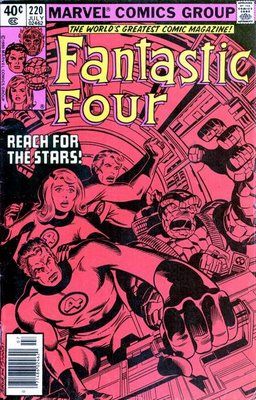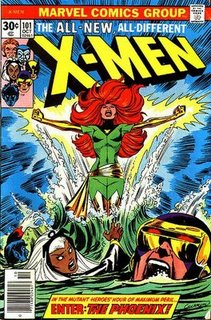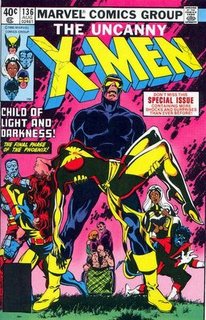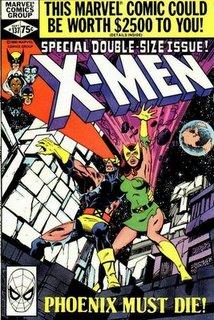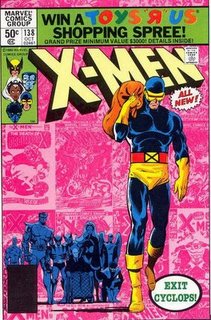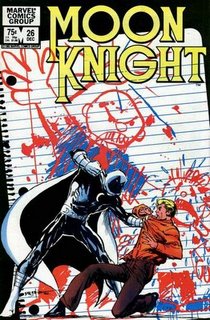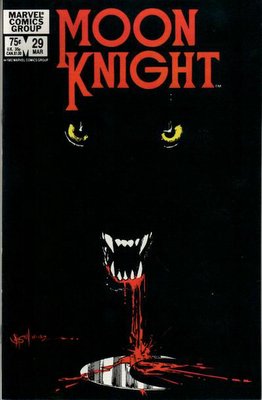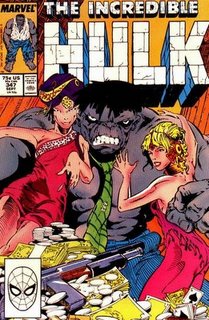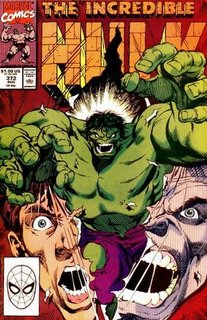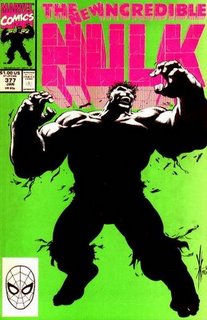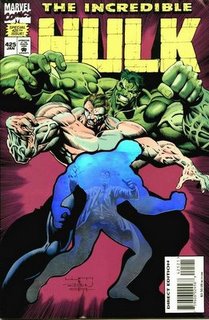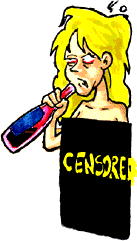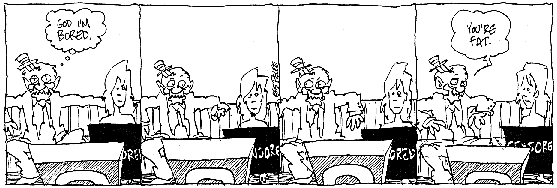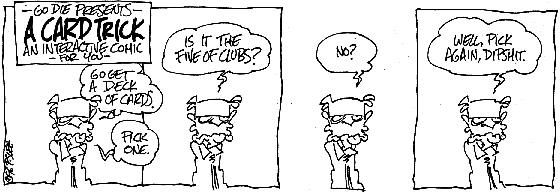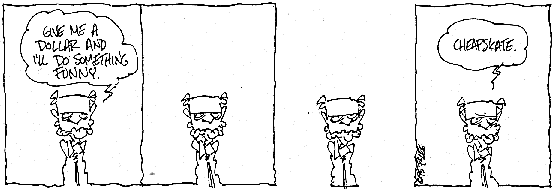Cronin, Our Lord And Master, as I've mentioned before, gets comics downloaded directly into his brain as a part of his Faustian bargain with Marvel's Mephisto (or Mike Carey's by-way-of-Neil-Gaiman's Lucifer, or maybe even Garth Ennis' First of the Fallen), so he has already reviewed a couple of these books, but some of us have remained pure and will get our rewards in comic book heaven when 72 virgins, wearing belly shirts and Catholic schoolgirl skirts and all of whom know who Peter Corbeau is, will bring us whatever first printing comic book we desire and say stuff like "You know, there are
other things 72 virgins could do for you ..." and we, like Homer when he has two wives, envisions them both doing yardwork. That will be our reward for having to slog our way through the 90-degree heat (it's freakin' April, and it's 90 degrees, or 30 degrees, if you're a Commie who uses the Centigrade scale) to the comic book shoppe and pick up our books the old-fashioned way! And we'll all laugh at Cronin in HELL!!!! Bwah-ha-ha-ha!
Where the hell was I? Oh, that's right, this week's comics. I'm old and lose the thread sometimes. Forgive me, gentle readers! As an added bonus this week, I will stop in the middle of reviewing books and muse about whether Dan DiDio needs to be punched in the brain.
Batman #652 by James Robinson, Don Kramer, Michael Bair, and Wayne Faucher
$2.50, DC
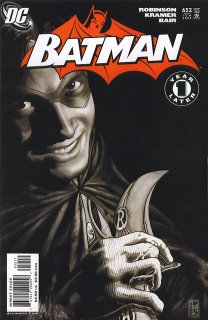
I have many questions about this issue and the whole story arc in general. Not that I'm not enjoying it, and per Cronin's directive, I think it's good enough to recommend to you, the discerning reader, but I still have some questions. To wit:
1. Did the writers get an e-mail from either Dan DiDio or Grant Morrison (isn't he the Continuity God at DC these days?) laying out the groundwork for One Year Later? I'm just wondering if these random comments by various characters in this book and in the other OYL book I read this week (Catwoman, so you're not on pins and needles) are going to be extrapolated upon in 52, or if Robinson and Pfeifer just think it's cool to throw stuff like this in there. Bullock's return and the allusions to Commissioner Akins being corrupt and Gordon and Bullock sniffing it all out, for instance. Are we going to see Harvey in action as Gotham's protector in 52? I'm just wondering.
2. Why does Harvey blow himself up? Okay, I know he didn't blow himself up, but that was a weird scene. Batman asks him if he's the killer, he hedges and hides behind some stupid "innocent until proven guilty" thing (idiotic Constitution!) and then triggers a bomb in his desk? Way to prove that you're sane, Harvey. Are we going to find out how they "cured" him, or has that already been done? I would think that would be something that would make some ripples, but I hadn't seen anything about it prior to this story. For years the line from DC was that plastic surgery was unfeasible because the damage was too deep. What happened?
3. Orca? Really?
Okay, that last one was kind of a lame question, but when you have a lame - and I mean LAME with a capital LAME - villain like Orca, the question simply becomes: Orca? Really? I said I didn't mind that they killed the Ventriloquist, but the Ventriloquist is a billion times better than Orca. I don't even know a lot about Orca and I know she's lame. Orca?
The mystery deepens in this issue, and the best of the book - shockingly enough for a Robinson-written issue - is the conversation between Bullock and Batman. This is one of the reasons why we buy Batman - he's a flawed individual, surrounded by other flawed individuals, all trying to make their way in a deeply flawed city. That's part of the reason why Batman realizes he needs Tim. Robin has not been irreparably damaged by Gotham (although, you know, DC is working on that - go, DC!) and he allows Batman to see a living embodiment of why he does what he does. If DC can just keep that while still having lots of murder and horror in Gotham, they'll have done a good job.
Freakin' Orca?
Catwoman #54 by Will Pfeifer, David Lopez, and Alvaro Lopez
$2.50, DC
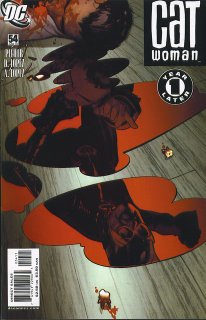
Look at the teeth on that cover! I think they're bigger than Angle Man's head!
I'm not sure why Pfeifer begins this book with a two-page flashback showing the drama of ... a pregnancy test! I mean, we know Selina had a baby last month, so why on earth do we need to see when she finds out she's pregnant? It's only two pages long, so I don't bother with it that much, but it's weird.
This is a weird title, in that each issue is pretty good, and I like what Pfeifer is doing, but each one on its own is just adequate. It's like a Snickers bar - good while you're eating it, but then it's gone and you just move on. That means I should probably drop the book, but I still enjoy what is going on in the book. Darn it. The conflict continues!
The interesting development this issue, of course, is the new Film Freak, who looks like a neat character and is, of course, mean and nasty. He got the footage of Holly beating the crap out of Angle Man once he talked his way out of killing her (stupid James Bond moment!) and now he wants a repeat, because I'm sure his ratings went through the roof when he aired it. The Film Freak, of course, was created by Mr. Douglas Moench back in the 1980s, and he tried to kill Selina more than once, but that Selina is different from this Selina (or whatever the hell DC would have us believe), so this Selina doesn't say, "Holy shit - a guy with the same name tried to kill me back in the 1980s!" I don't mind, though - someone commenting on Cronin's post about this book mentioned that they really liked the old Film Freak, and while I agree, he was kind of a one-note villain, so I don't mind that he's dead. This guy is creepy.
I'm really, really, really, really, really hoping Pfeifer does a lot with this idea of filming violence and broadcasting it for ratings. It's been done before (at least once, in Detective #596-597, but probably in other books as well), but it's always an interesting thing. Come on, Will, you can do it!
Freakin' Orca????
Checkmate #1 by Greg Rucka and Jesus Saiz
$2.99, DC
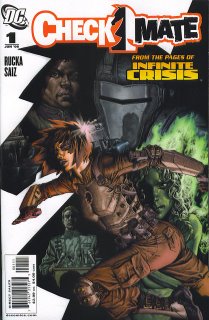
There are very few comic book characters whose appearance in a book will get me to buy it. I can count them on one hand - the hand of Mordecai "Three-Finger" Brown, even! They are: Psylocke, Dazzler, Moon Knight, and Fire. I have been trying very hard to resist buying the latest Uncanny X-Men books because Psylocke is in them, because I'm sure they suck. But the lure is there. The lure!!!!
So I bought Checkmate. Beatriz DaCosta, meng! Look - there she is on that nifty Lee Bermejo cover. There she is sticking a knife in a Kobra "hatchling's" neck. ("Hatchling," Rucka? Really?) There she is lighting things up and burning another bunch of Kobra Kannon Fodder™. Ah, Beatriz, you Brazilian Beauty. Why aren't you a superstar in the DCU? WHY?!?!?
Okay, so what about the quality of the book? Well, Rucka is part of everyone's favorite punching bag on yonder Internets, but I like him. Okay, he's not perfect, but I hold onto the memory of Whiteout and hope he still has that kind of comic goodness in him. I keep hearing good things about Queen & Country, and this seems like that kind of book, which he is good at. So I'm willing to give it a chance.
Checkmate is actually an intriguing idea - as Alan Scott puts it, "policing and monitoring global metahuman activity, while providing a diplomatic conduit for super-powered conflict resolution" - and it should be interesting to see what Rucka does with that. I would hope he picks up the international superhero torch that Ostrander carried so well for so many years (through Firestorm, Suicide Squad, and The Spectre) and that The God Of All Comics briefly revived with the Ultramarines (before he, you know, killed them all). This is a good start, as we get a race against time to prove that the cheese-eating surrender monkeys in France supplied poison gas to Kobra to attack the Vatican (why would the French do that - they're super-Catholics!) so that Alan Scott and Amanda Waller can get a resolution through the United Nations to continue Checkmate's charter, a resolution they believe the French will squelch because Checkmate thwarted the aforementioned attack on the Pope's crib. Phew! Got all that? So we go back and forth between the UN and the team's assault on Kobra Central to secure said proof. Oh, the drama!
It all goes kablooey at the end, as we knew it would, and Checkmate's charter is revoked, but not by the C-E S.M (the French). I'll let you find out who screws them! It sets up some nice tension for the future, and I'm on board for while, at least. Until Rucka kills Beatriz. NOOOOOOO!
Again, I have questions. Bear with me:
1. What's up with Sasha Bordeaux and that thing on her eye? I'm sure it's been explained at some point, but the last time I checked in on her (Detective #775, and yes, I know a lot has happened since then), she didn't have it. It's weird.
2. I miss Fat Amanda Waller. Okay, that's not a question. Here's a question: when did Amanda get a personal trainer and chef? I miss Fat Amanda (see, I bring it all back around for you!).
3. JSA two-parter! What's up with Alan Scott's eye - he's wearing an eyepatch but looks nothing like a pirate, so I'm thinking that's not why he's wearing it. And does Mr. Terrific have the absolute worst superhero costume in recorded history? I know it debuted in The Spectre, so he was Ostrander's baby and the look was probably designed by Tom Mandrake, but holy crap is it awful. And I read somewhere something made me chuckle (if you wrote it, sorry I didn't remember it was you) - Mr. Terrific is a black man wearing blackface. Now that's weird.
4. Orca? Really?
All in all, a nice start. Go check it out. Worship at the altar of Beatriz DaCosta!!!!!
Okay, now I have to stop and consider whether, upon meeting Dan DiDio, I would not even say hello and simply punch him in the brain. I have gotten into two (2) fights in my life, both with the same kid, and the last time was when I was in my early teens (15, maybe?) so I am not terribly violent, but I stopped to read his little notes at the back of my DC purchases this week. In Batman and Catwoman, he gives us "notes" that he wrote to Geoff Johns about Infinite Crisis #7. Stuff like: "Page 10 - Ooooh, so that's who The Flash is. Will check to see if Editor Joan Hilty has the same one in the new FLASH series." and "Page 18 - Dude, we did not go to all that trouble bringing Hal back just to kill him again. Please change it." It really didn't bother me that much, but if you're going to waste space with that and the pictures of four covers for upcoming books, why not bring back letters pages? Or actual previews of upcoming books instead of idiotic, "clever" crap like this? Then, in Checkmate, he waxes poetic about Superboy going to Great Phantom Zone in the Sky. Dude (DiDio looks older than I am, but since he's going around acting like he's in high school and calling people "dude," I can too), he's a fictional character, and not one with a particularly long history, either, and certainly not as well loved as what's-her-name and what's-his-name - you know, those two whose deaths in Crisis on Infinite Earths were big things. I mean, who cares, right? If he stays dead, it will be because nobody who has proven to be a sales winner (The God Of All Comics, for instance) gives you a call and says, "I have a great idea for a Kon-El mini-series, dude! We have to resurrect him!" On the other hand, if Warren Ellis called tomorrow and pitched a story in which Kon-El comes back as a nihilistic superhero hell-bent on killing all the puppies in the world while drinking furniture varnish straight up and grabbing his crotch every so often, you would jump through hoops to make it happen! The only reason no one has brought the pre-Crisis Supergirl back is because they keep creating new Supergirls! They should do a series called "Supergrrls!" where all the versions of Supergirl live together in a loft in TriBeCa and shop during the day and fight crime at night, all while lusting after the same hunky guys! Now that would be a series!
Anyway, Dan DiDio. I know you exist solely to pimp your product, but you don't need to pimp Infinite Crisis. Everyone is already buying it or at least not buying it but mocking it, which means they're aware of it. Spare us, please. And don't take that call from Warren Ellis, please!
So. If I met him on the street, should I punch him in the brain? Just wondering.
Gødland #10 by Joe Casey and Tom Scioli
$2.99, Image

You know, Gødland is as close to a perfect comic book as we have right now. I like other books more, but for a sheer adrenalin shot and the kinds of things that you can only do in comic books, nothing comes close. The two media most closely associated with comic books - movies and books - could not do justice to this comic. A movie would be too expensive and we'd have to cut some of the subplots. Therefore, we'd have to ditch the appearance of Supra, Ed, and Eeg-oh on one of the pages (probably). A prose book, on the other hand, would forsake the glorious art of Scioli and rely on describing every single detail through words, and we'd miss the awesome glory of the pyramid thing slowly settling down over New York and destroying the Statue of Liberty, and the Psychotronic Wheel of Influence wouldn't have the same punch. Casey is holding nothing back, and that's a good thing. And I haven't even mentioned that Neela has flown out of the solar system and who the hell knows where she's going?
Another great issue. It's really hard to describe the wonderful goodness that this comic brings every month. Just a wild ride that never slows up but still gives us character development (Adam's dad didn't love him!) and humor - Friedrich Nickelhead even plugs The Milkman Murders - I wonder why ...
If you don't buy this you deserve to have Dan DiDio come to your house and tell you why Infinite Crisis #6 is the single greatest comic book ever published in this or any other dimension. And you don't want that, do you????
X-Factor #6 by Peter David and Dennis Calero
$2.99, Marvel
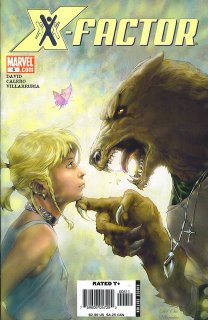
This continues to be a typical Peter David book. That may be good, or that may be bad, depending on your taste in Peter David books. If you don't like Peter David, this will probably do little to change your mind. I like Peter David, so I enjoy the witty banter, the caustic comments, the vague menace, and the unsolved mysteries. But that's just me.
This is Layla Miller's story, for the most part, as she is thrown out of X-Factor by a suspicious Rictor ("Rictor" is such a stupid name - it sounds too much like "rictus," which always leads me to unpleasant places) - "thrown out" might be too harsh, but he does question what she knows about Theresa's attack, which leads her to leave - and returns to the orphanage whence she came, who's willing to take her back now that she doesn't have mutant powers anymore. Jamie and Rahne go to get her back, but she's not sure if she should, because she did know that Theresa would be attacked, and she let it happen because it was "supposed to." It's all very chaos theory, as she explains. And it's interesting, because as usual, David is not "writing for the trade" - these things have long-term consequences, and at the end, when Layla apparently brings a butterfly back to life, he throws us yet another curveball. The nice thing about David is I've read enough of his work to know he has plans, and he's not just tossing in ideas because they're "cool." I hope the book lasts long enough to see them through.
This is another very good book that is getting better. Just so you know.
MINI-SERIES I BOUGHT BUT DID NOT READ.
American Way #3 (of 8) by John Ridley, Georges Jeanty, Ray Snyder, and Karl Story
$2.99, DC/Wildstorm
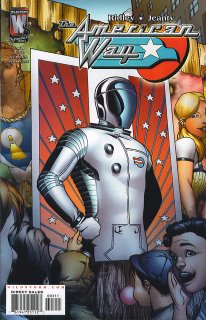
I mentioned last time that I had decided to buy the rest of it after reading the first two issues. Don't let me down, Ridley! You would rue that day!
Seven Soldiers: Frankenstein #4 by The God Of All Comics and Doug Mahnke
$2.99, DC

Oh dear. Only one more issue to go, and then I get to sit down and read all of these at once. Will my head explode? Will I understand English afterwards? Will I be transported into the Morrison-verse, where dung beetles rule like emperors and Marlo Thomas is the top box-office star of all time? I like how Seven Soldiers #1 is, according to the back of the book, "in stores April 5, 2006." A little behind schedule, are we? I expect to read the finished product some time before the end of the year. We'll see.
So that's it for this week. Sorry I was ranting. Utter stupidity from the management of major comic book companies does that to me. But remember - there's always Gødland to make things better.
ORCA????Read More



